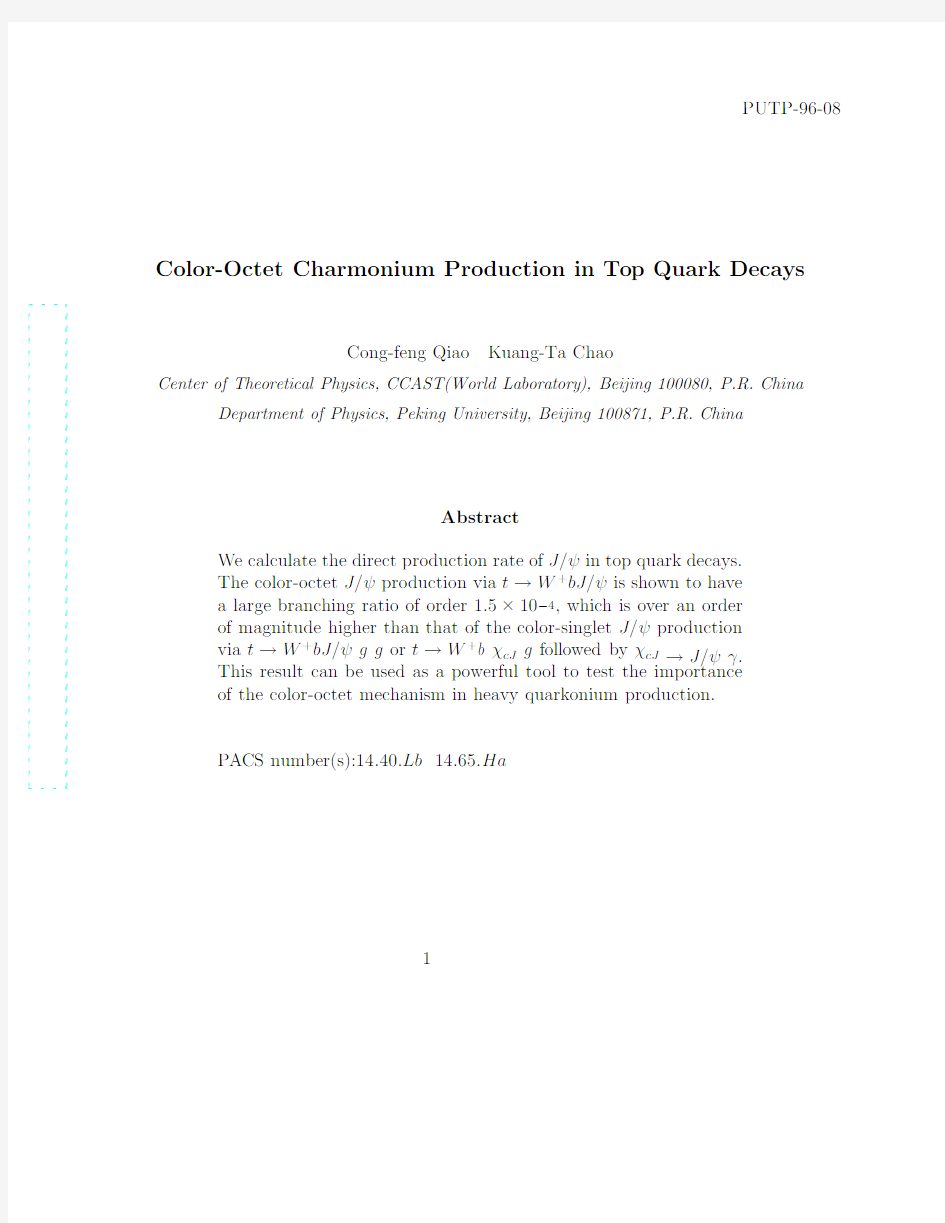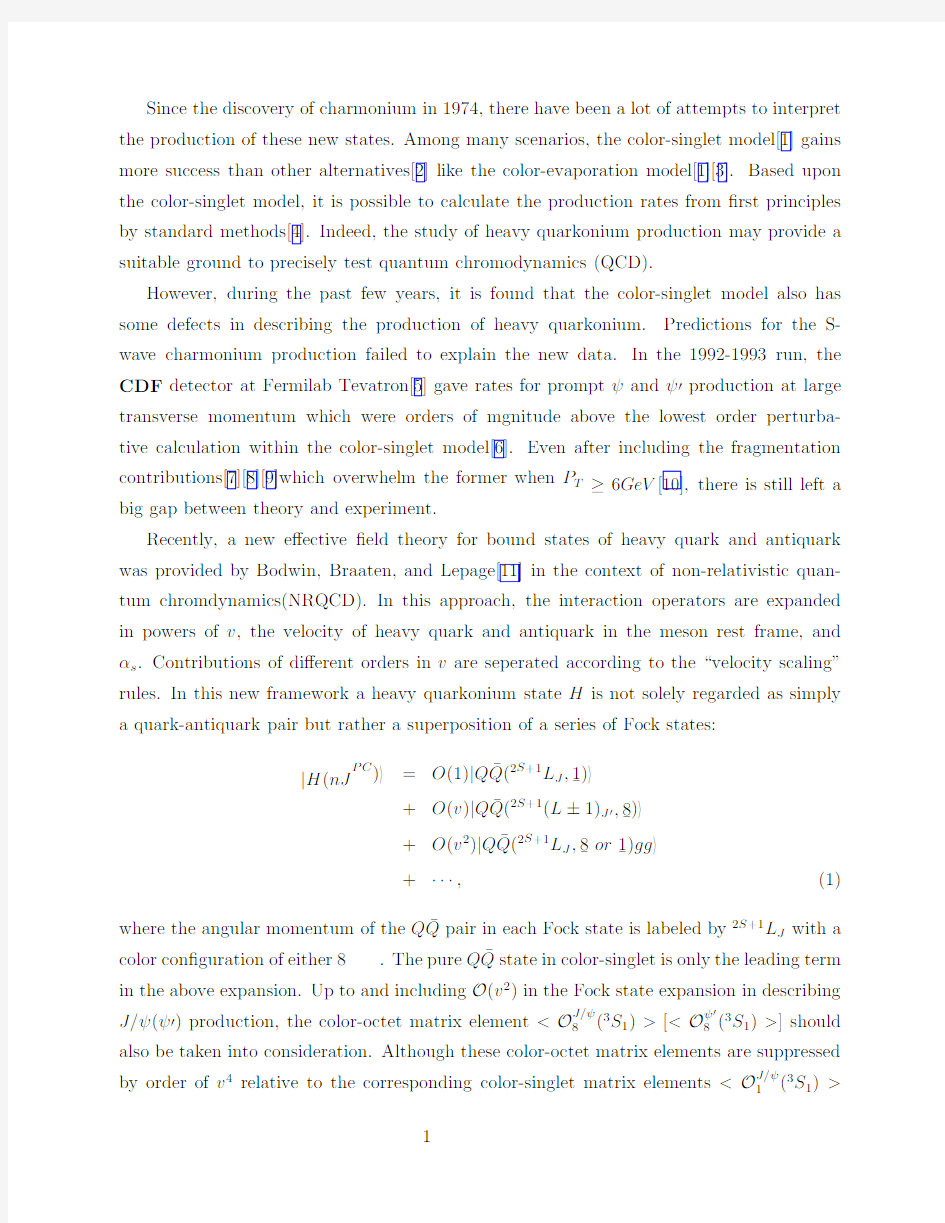

a r X i v :h e p -p h /9606462v 1 28 J u n 1996PUTP-96-08
Color-Octet Charmonium Production in Top Quark Decays
Cong-feng Qiao Kuang-Ta Chao Center of Theoretical Physics,CCAST(World Laboratory),Beijing 100080,P.R.China Department of Physics,Peking University,Beijing 100871,P.R.China Abstract We calculate the direct production rate of J/ψin top quark decays.The color-octet J/ψproduction via t →W +bJ/ψis shown to have a large branching ratio of order 1.5×10?4,which is over an order of magnitude higher than that of the color-singlet J/ψproduction via t →W +bJ/ψg g or t →W +b χcJ g followed by χcJ →J/ψγ.This result can be used as a powerful tool to test the importance of the color-octet mechanism in heavy quarkonium production.PACS number(s):14.40.Lb 14.65.Ha
1
Since the discovery of charmonium in1974,there have been a lot of attempts to interpret the production of these new states.Among many scenarios,the color-singlet model[1]gains more success than other alternatives[2]like the color-evaporation model[1][3].Based upon the color-singlet model,it is possible to calculate the production rates from?rst principles by standard methods[4].Indeed,the study of heavy quarkonium production may provide a suitable ground to precisely test quantum chromodynamics(QCD).
However,during the past few years,it is found that the color-singlet model also has some defects in describing the production of heavy quarkonium.Predictions for the S-wave charmonium production failed to explain the new data.In the1992-1993run,the CDF detector at Fermilab Tevatron[5]gave rates for promptψandψ′production at large transverse momentum which were orders of mgnitude above the lowest order perturba-tive calculation within the color-singlet model[6].Even after including the fragmentation contributions[7][8][9]which overwhelm the former when P T≥6GeV[10],there is still left a
big gap between theory and experiment.
Recently,a new e?ective?eld theory for bound states of heavy quark and antiquark was provided by Bodwin,Braaten,and Lepage[11]in the context of non-relativistic quan-tum chromdynamics(NRQCD).In this approach,the interaction operators are expanded in powers of v,the velocity of heavy quark and antiquark in the meson rest frame,and αs.Contributions of di?erent orders in v are seperated according to the“velocity scaling”rules.In this new framework a heavy quarkonium state H is not solely regarded as simply a quark-antiquark pair but rather a superposition of a series of Fock states:
|H(nJ P C) =O(1)|QˉQ(2S+1L J,1ˉ)
+O(v)|QˉQ(2S+1(L±1)J′,8
ˉ
)
+O(v2)|QˉQ(2S+1L J,8
ˉor1
ˉ
)gg
+···,(1)
where the angular momentum of the QˉQ pair in each Fock state is labeled by2S+1L J with a color con?guration of either8.The pure QˉQ state in color-singlet is only the leading term in the above expansion.Up to and including O(v2)in the Fock state expansion in describing J/ψ(ψ′)production,the color-octet matrix element 8 (3S1)>[ by order of v4relative to the corresponding color-singlet matrix elements 1 (3S1)> [ The success of the Standard Model(SM)[18][19][20]suggests that the top quark must exit [21].Recently,from the direct search at the Tevatron,the CDF and D0groups con?rmed the existence of a heavy top quark[22][23],with a mass of(176±8±10)GeV or(199+19 ?21±22) GeV.The next experimental studies will focus on the determination of its properties.Among others,the measurement of top quark decays into heavy quark mesons which are made of charm or bottom quark and antiquark,will be of special interest.In particular,the charmonium production in top quark decays will provide very useful information in testing the Standard Model. In the Standard Model,charmonium(e.g.J/ψ)may be produced via the?avor changing neutral current transition t→cg[24]followed by the charm quark fragmentation c→J/ψc or the gluon fragmentation g→J/ψ,but the rates of these processes are very small within the Standard Model and hence sensitive to the new physics beyond the Standard Model[25]. On the other hand,however,since in the Standard Model the dominant decay mode of top quark is t→W+b[26],the dominant direct charmonium production is expected to pro-ceed via t→W+bg?with the virtual gluon g?fragmentation into charmonium.There are three subprocesses for J/ψproduction via t→W+bg?:(i)color-octet gluon fragmenta-tion g?→J/ψ;(ii)color-siglet gluon fragmentation g?→J/ψgg;(iii)color-singlet gluon fragmentation g?→χcJ g followed byχcJ→J/ψγ,whereχcJ(J=0,1,2)are the P-wave states. The direct charmonium production appears at ordersα4s or over in the color-singlet model[27],whereas the color-octet production process given by t→W+bJ/ψ,as shown in Fig.1,is at orderα2s.Its amplitude may be written as A(t→W+bJ/ψ)=igg2s V tb2M T a?μψ?αWˉu(P′) γμ1 +γα(1?γ5) 1 dx1dx2(t→W+bJ/ψ)= g2α2s|V tb|2|M8(J/ψ)|2 2(m2t?x2){(M2?x2)(m2t+m2b?m2w?x2) ±λ12[(m2t?x2),m2b,m2w]}?M2, x?2=m2t?(m t?M)2,x+2=m2t?(m b+m w)2.(5) Hereλ(x,y,z)≡(x?y?z)2?4yz.Settingαs=0.253,m c=1.5GeV,m b=4.9GeV,m t= 176GeV[12],and|M8(J/ψ)|2=0.68×10?3GeV2[14],we get the branching ratio of B(t→W+bJ/ψ)≈1.46×10?4.(6) The dominant color-singlet prompt J/ψproduction process to be t→W+bg?with g?→J/ψgg,and g?→χcJ g followed byχcJ→J/ψγ,as shown in Fig.2.We can estimate the partial width following the way in Ref.[28].The di?erential decay rate of t→W+bg?is similar to Eq.(4),and can be easily obtained or found in Ref.[29].With the de?nition Γ(g?→AX)=πμ3P(g?→AX),(7) the decay distribution P(g?→χcJ g)and P(g?→J/ψgg)for the gluon of virtualityμcan be found in Ref.[4]and Ref.[30]. μ2P(g?→χc0g)=r(1?3r)2 1?r C p,(9) μ2P(g?→χc2g)=2r(1+3r+6r2) r dx J/ψ x+ x? dx1f(x J/ψ,x1;r),(11) where r≡M/μ,M is the mass of the relevant charmonium states,and C p=8α2s M5 ,C s= 5α3s M3 .(12) The function f in Eq.(11)is of the form[30] f(x J/ψ,x1;r)=(2+x2)x2 (2?x J/ψ)2(1?x2?r)2 + (x J/ψ?r)2?1 (2?x J/ψ)2 6(1+r?x J/ψ)2 (1?x2?r)(1?x1?r)r+ 1 2 (2?x J/ψ± In the numerical estimation,we takeαs=0.253,m c=1.5GeV,M=2m c,|R s(0)|2= 0.999GeV3,and|R′p(0)|2=0.125GeV5[31],and get B(t→W+bχc0g)·B(χc0→J/ψγ)=2.49×10?9,(16) B(t→W+bχc1g)·B(χc1→J/ψγ)=5.35×10?6,(17) B(t→W+bχc2g)·B(χc2→J/ψγ)=1.88×10?6,(18) B(t→W+bJ/ψgg)=1.39×10?6.(19) TheχcJ production rates depend on the infrared cuto?.Here we take the cuto?μ2min=2M2, which is the same as that in the fragmentation analysis[32].Adding the branching ratios together,we obtain the total color-singlet prompt J/ψproduction rate to be8.6×10?6, which is about a factor of20smaller than that via the color-octet production mechanism. In conclusion,we have considered the color-octet charmonium production in top quark de-cays,and found the branching ratio of this dominant process t→W+bJ/ψto be1.46×10?4, which is over an order of magnitude larger than that of color-singlet production processes. Such a large di?erence makes the process of charmonium production in top decay another important channel to identify color-octet qurkonium signals whenever there are enough top quark events at the Fermilab Tevatron,LHC(Large Hadron Collider),or NLC(Next Linear Collider)in the future. Acknowlegement This work was supported in part by the National Natural Science Foundation of China, the State Education Commission of China and the State Commission of Science and Tech-nology of China. References [1]See:for example,G.A.Schuler,Report No.CERN-TH/95-75;Report No.CERN-TH- 7170-94,and references therein. [2]T.J.Weiler,Phys.Rev.Lett.44,304(1980);V.Barger,W.-Y.Kueng,and R.J.N. Phillips,Phys.Lett.91B,253(1980),and references therein. [3]M.B.Einhorn and S.D.Ellis,Phys.Rev.D12,2007(1975);H.Fritzsch,Phys.Lett. B67,217(1977);M.Gl¨u ck,J.F.Owens,and E.Reya,Phys.Rev.D17,2324(1978); J.Babcock,D.Silvers,and S.Wolfram,Phys.Rev.D18,162(1978). [4]J.H.K¨u hn,J.Kaplan,and E.G.O.Sa?ani,Nucl.Phys.157,125(1979);B.Guberina, J.H.K¨u hn,R.D.Peccei,and R.R¨u ckl,Nucl.Phys.174,317(1980). [5]CDF Collaboration,F.Abe et al.,Phys.Rev.Lett.693704(1992);Phys.Rev.Lett. 71,2537(1993);Contribution to the International Conference on High Energy Physics, Glasgow,Scotland,1994,Report No.FERMILAB-CONF-94/136-E(hep-ex/9412103). [6]E.W.N.Glover,A.D.Martin,and W.J.Stirling,Z.Phys.C38,473(1988). [7]E.Braaten et al.,Phys.Lett.B333,548(1994). [8]M.Cacciari and M.Greco,Phys.Rev.Lett.73,1586(1994). [9]D.P.Roy and K.Srindhar,Phys.Lett.B339,141(1994). [10]H.A.Doncheski,S.Fleming,and M.L.Mangano,Report No.FERMILAB-CONF- 93/348-T. [11]G.T.Bodwin,E.Braaten,and G.P.Lepage,Phys.Rev.D51,1125(1995). [12]E.Braaten,and S.Fleming,Phys.Rev.Lett.74,3327(1995). [13]M.Cacciari et al.,Phys.Lett.B356,553(1995). [14]P.Cho and A.K.Leibovich,Report No.CALT-68-1988(hep-ph/9505329)and Report No.CALT-68-2026(hep-ph/9511315). [15]K.Cheung,W.Y.Keung,and T.C.Yuan,Phys.Rev.Lett.76,877(1996). [16]P.Cho,Report No.CALT-68-2020,1995. [17]K.W.Tang and M.V¨a nttinen,Report No.NORDITA-96/18p;ibid,Report No.SLAC- PUB-95-6931. [18]W.Hollik,in Proceedings of the XVI International Symposium on Lepton-Photon Inter- actions,Cornell University,Ithaca,N.Y.,Aug.10-151993;M.Swartz,in Proceedings of the XVI International Symposium on Lepton-Photon Interactions,Cornell University, Ithaca,N.Y.,Aug.10-151993. [19]G.Altarelli,in Proceedings of Interational University School of Nuclear and Partical Physics:Substructures of Matter as Revealed with Electroweak Probes,Schladming, Austria,24Feb-5Mar.1993. [20]G.Altarelli,CERN-TH-7319/94,talk at1st International Conference on Phenomenol- ogy of Uni?cation:from Present to Future,Rome,Itali,23-26Mar1994. [21]G.L.Kane,in Proceedings of the Workshop on High Energy Phenomenology,Mexico City,July1-10,1991. [22]F.Abe,et al.(CDF Collaboration),Phys.Rev.Lett.74,2626(1995). [23]S.Abachi,et al.(D0Collaboration),Phys.Rev.Lett.74,2632(1995). [24]J.L.Diaz-Cruz et al.,Phys.Rev.D41(1990)891;B.Dutta Roy et al.,Phys.Rev.Lett. 65(1990)827. [25]Kuang-ta Chao,Cong-feng Qiao,and Feng Yuan,in preparation. [26]V.Barger and Phillips,Collider Physics(Addison-Wesley,Reading,MA,1987). [27]C.-F.Qiao,C.-S.Li,and K.-T.Chao,Report No.PUTP-96-03(hep-ph/9603275). [28]K.Hagiwara,A.D.Martin,and W.J.Stirling,Phys.Lett.B267,527(1991);316, 631(E)(1993). [29]G.Couture,Phys.Rev.D40,2927(1989);42,1855(E)(1990);V.Barger,A.Stange, and W.-Y.Keung,Phys.Rev.D42,1835(1990). [30]W.-Y.Keung,Phys.Rev.D23,2072(1981). [31]E.Eichten and C.Quigg,Phys.Rev.D52,1726(1995). [32]E.Braaten and T.C.Yuan,Phys.Rev.D50,3176(1994). Figure Captions Fig.1.Color-octet Charmonium production process in top quark decays. Fig.2.Diagrams for color-singlet J/ψproduction.(a)via g?→J/ψgg(b)via g?→χcJ g→J/ψγg.For diagram(a)x i≡2E i/μwith i=J/ψ,g1,g2are the energy fractions carried by the decay products in g?rest frame normalized toμ≡m(g?).